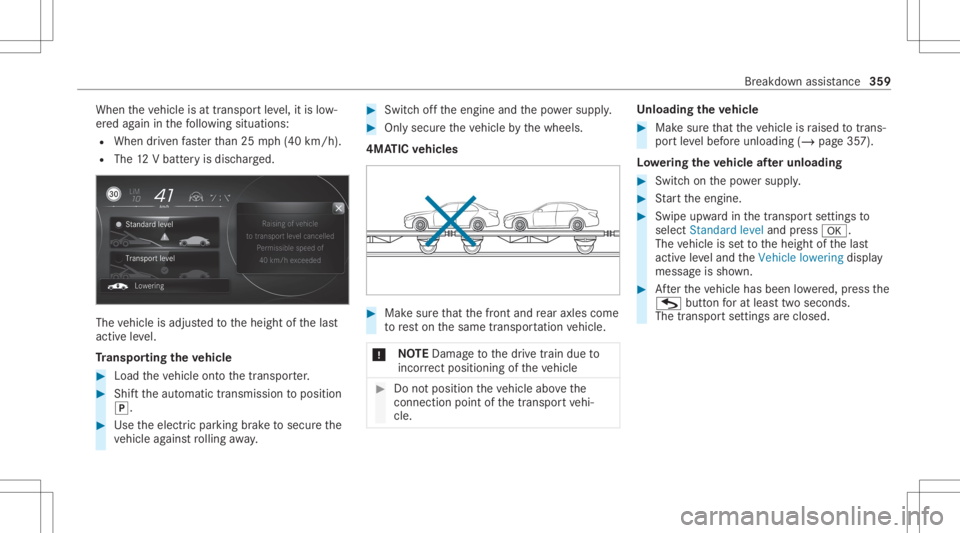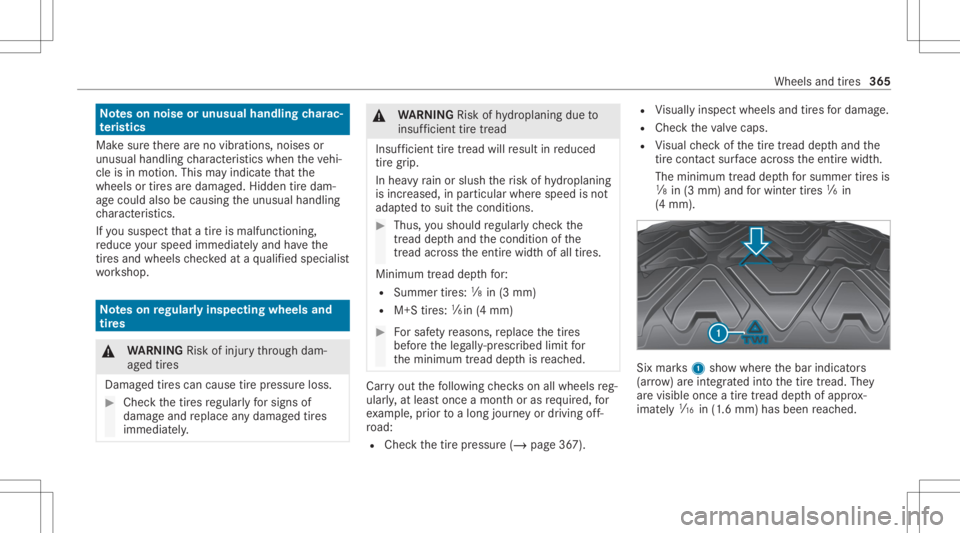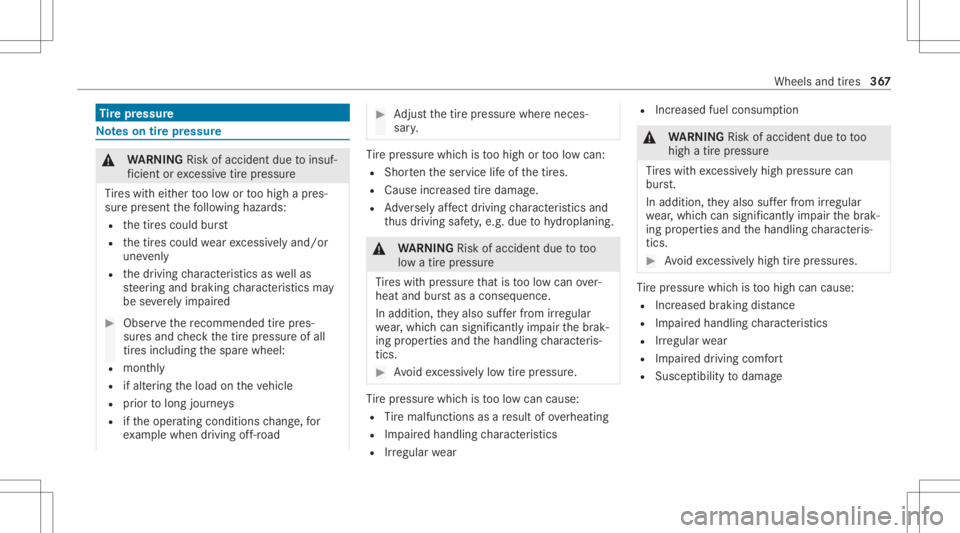2022 MERCEDES-BENZ S CLASS wheel
[x] Cancel search: wheelPage 357 of 610

R
Mak esur eth at detach able partsarere con‐
nect edinthesame way. To
w star ting ortowing away Pe
rm itted towing methods *
NO
TEDama gefrom automatic braking If
one ofthefo llo wing functionsis switc hed
on, theve hicle brak es aut omatically incer‐
ta in situat ions:
R ActiveBr ak eAssi st
R ActiveDis tance AssistDIS TRONI C
R HOLD functio n
R ActivePa rking Assist
To avo iddamag eto theve hicle, deactiv ate
th ese systems inthefo llo wing orsimilar sit‐
uation s: #
Dur ing towing #
Inacar wash Mer
cedes-Benz recomme ndstransp orting your
ve hicle inthecase ofabr eakdo wn,rath er than
to wing itaw ay.
Fo rto wing, useato w rope ortow bar withbo th
axle son thegr ound. Donotuse tow bar systems
(/ page27 1).
* NO
TEDama getotheve hicle duetotow‐
ing away inc orrectly #
Obs erve theins truction sand noteson
to wing away. To
wing withara ised axle: towing should be
per form ed byato wing company. Ve
hicl eswith rear whe eldrive Pe
rm itted towing methods
Bo th axle son
th egr ound Ye
s,maximum 31mile s
(50 km) at31 mp h(5 0km/h)
Fr ont axle
ra ised No
Re ar axle
ra ised Ye
s,ifth esteer ing wheel is
fi xe din thecent erposition
wit hast eer ing wheel lock 4MA
TICvehicl es Pe
rm itted towing methods
Bo th axle son
th egr ound Ye
s,maximum 31mile s
(50 km) at31 mp h(5 0km/h)
Fr ont axle
ra ised No
Re ar axle
ra ised No Br
eakdo wnassis tance 35
5
Page 359 of 610

#
Donotacti vate theHOLD function. #
Deact ivat eth eto w- aw ay alar m
(/ page10 1). #
Deactiv ateAc tiveBr ak eAssi st
( / pag e236). #
Shif tth eaut omatic transmiss iontoposition
005C. #
Release theelectr icpar king brak e. &
WARNIN GRisk ofacci dent dueto limi‐
te dsaf ety-re lat ed func tionsdur ing the
to wing proce ss
Saf ety-re lat ed func tionsar elimit edorno lon‐
ge rav ailable inthefo llo wing situat ions:
R The ignit ionisswitc hedoff.
R The brak esy stem orpowe rst eer ing sys‐
te m ismalfu nctioning.
R The ener gysupp lyor theon- boar delectr i‐
cal system ismalfunct ioning.
When your vehicle istowe daw ay,signif i‐
cant lymor eef fort ma ybe requ ired tosteer
and brak eth an isno rm allyre qu ired. #
Use ato w bar . #
Mak esur eth at thesteer ing wheel can
mo vefreely beforeto wing theve hicle
aw ay. *
NO
TEDama gedue toexcess ive tracti ve
po we r If
yo upull away shar ply, thetractiv epo we r
ma ybe toohigh andtheve hicles couldbe
damag ed. #
Pull away slo wlyand smoo thly. Lo
adi ng the vehicl efo rtr ans port Re
quiremen ts:
R The vehicle isstatio nary.
R The engine isswitc hedoff.
R The driver displa yis in theinitial stat ewit h
no men usopen (/page27 2).Tr ans portis
also possiblewithawa rning mess agevisible.
R The 12Vbatt eryis ch arge d. #
Ifnec essar y,se tth esy stem languag e
(/ page298). #
Obser vetheno teson towing away
( / pag e356). #
Connec tth eto wing devic eto theto wing eye
in order toload theve hicle. #
Switc hon thepo we rsupp ly(/ pag e18 1). #
Shif tth eaut omatic transmiss iontoposition
005C.
% The automatic transm ission maybe locked
in posit ion005Dintheeve ntofdama getothe
electr ics.Toshif tto 005C ,pr ov ide theon-
boar delectr icalsystem withpo we r
( / pag e353).
* NO
TEPossible damag eto theve hicle
when loading orunloading When
loading orunloading, theve hicle must
be raised totrans portleve l.
If th etranspor tse ttings areno tsho wnorthe
Vehicle notready forload ingdispl aymes‐
sag eis sho wn, theve hicle mayno tbe loaded
or unloaded. Br
eakdo wnassis tance 35
7
Page 361 of 610

When
theve hicle isat transpor tle ve l,it is low‐
er ed again inthefo llo wing situat ions:
R When driven faster than 25 mph(4 0km/h).
R The 12Vbatt eryis disc harg ed. The
vehicle isadjus tedto theheight ofthelas t
activ eleve l.
Tr anspo rting theve hicl e #
Load theve hicle ontoth etra nspor ter. #
Shif tth eaut omatic transmiss iontoposition
005D. #
Use theelectr icpar king brak eto secur eth e
ve hicle agains tro lling away. #
Swi tchof fth eengine andthepo we rsupp ly. #
Onlysecur eth eve hicle bythewheels.
4MA TICvehicl es #
Mak esur eth at thefront and rear axle scom e
to rest on thesame transpor tatio nve hicle.
* NO
TEDama getothedr ive train due to
inc orrect pos itioning oftheve hicle #
Donotposition theve hicle abovethe
connecti onpointofthetranspor tve hi‐
cle. Un
loading theve hicl e #
Mak esur eth at theve hicle israised totrans ‐
po rtleve lbef oreunloadin g(/ page35 7).
Lo we ring theve hicl eaf te runl oad ing #
Swi tchon thepo we rsupp ly. #
Startth eengine. #
Swipe upwardin thetranspor tse ttings to
select Standard levelandpress 0076.
The vehicle issetto theheight ofthelas t
activ eleve land theVehicle lowering display
messag eis sho wn. #
Afterth eve hicle hasbeen lowe red, press the
G buttonforat lea sttwose cond s.
The trans portsettin gsareclosed. Br
eakdo wnassis tance 35
9
Page 367 of 610

No
teson noise orunusua lhand lingcharac‐
te rist ics
Mak esur eth er ear eno vibr ations, noisesor
unusual handling charact eristic swhen theve hi‐
cle isin mo tion. Thismayindicat eth at the
wheels ortires aredamag ed.Hidde ntir edam‐
ag ecould alsobecausin gth eunusual handling
ch aract eristic s.
If yo ususp ectthat atir eis malf unctionin g,
re duce your spee dimm ediat elyand have the
tir es and wheelsch eckedat aqu alif ied spec ialist
wo rkshop. No
teson regular lyinspect ingwheels and
tir es &
WARNIN GRisk ofinju rythro ugh dam‐
ag ed tires
Dam aged tires can caus etir epr ess ureloss . #
Chec kth etir es regular lyforsigns of
dama geand replace anydamag edtires
immediat ely. &
WARNIN GRisk ofhydroplaning dueto
insuf ficie nttiretrea d
Insu fficien ttir etread willresult inreduced
tir egr ip.
In hea vyrain or slush therisk ofhydroplaning
is incr eased, inpar ticular wherespeed isno t
adap tedto suit thecon ditions . #
Thus, yousho uld regular lych eckth e
tr ea dde pthand thecon dition ofthe
tr ea dacr oss theent ire widt hof all tires.
Minimum tread depthfor:
R Summ ertires: 00CEin(3 mm)
R M+S tires: 00CFin (4mm) #
Forsaf etyre ason s,replace thetir es
bef oreth eleg ally -prescr ibed limit for
th eminimum tread depthisreac hed. Car
ryout thefo llo wing checks on allwheels reg‐
ular ly,at leas tonce amont hor as requ ired, for
ex am ple, prior toalon gjo ur ne yor drivin gof f-
ro ad:
R Chec kth etir epr essur e(/ page36 7). R
Visual lyinspect wheelsandtires fordama ge.
R Chec kth eva lve caps.
R Visual checkof thetir etread depthand the
tir econt actsurface across theent ire widt h.
The minimum tread depthforsummer tires is
00CE in(3 mm) andforwint ertires 00CF in
(4 mm). Six
mar ks1 showwher eth ebar indicat ors
(ar row )ar eint egr ated intoth etir etread. They
ar evisible onceatir etread depthofappr ox‐
imat ely00CD in(1.6 mm) hasbeen reac hed. Whee
lsand tires 365
Page 368 of 610

No
teson sno wch ains &
WARNIN GRisk ofacci dent dueto inc or‐
re ct mou nting ofsno wch ains
If yo uha ve mount edsno wch ains tothefront
wheels, thesno wch ains maydr ag agains t
th eve hicle body orchassis components.
This couldcaus edamag eto theve hicle or
th etir es. #
Nevermount snowch ains onthefront
wheels. #
Onlymount snowch ains onthere ar
wheels inpair s. *
NO
TEDama getocom pone ntsofthe
ve hicle body orchassis duetomount ed
sno wch ains If
yo umoun tsn ow chains tothefront wheels
of 4MA TICvehicles, youma ydamag eco mp o‐
nent sof theve hicle body orchassis . #
Onlymount snowch ains tothere ar
wheels of4MA TICvehicles. Obser
vethefo llo wing noteswhen usingsnow
ch ains :
R Snow chains areon lype rm issible forcer tain
wheel/t ire com binat ions.Yo ucan obtain
inf ormat ionabout this from anaut hor ized
Mer cedes -Benz Cent er.
R Forsaf etyre ason s,on lyuse snow chains that
ha ve been specif icallyapproved foryo ur
ve hicle byMer cedes-Ben z,or sno wch ains
wit hth esame qualit yst andar d.
R Ifsn ow chains areins talled, themaximum
per missible speedis30 mph(50 km/h).
R Vehicl eswith Activ ePa rking Assis t:Do
no tuse ActivePa rking Assistwhen snow
ch ains areins talled.
R Vehicl eswith leve lcontr ol:Ifsno wch ains
ar eins talled, onlydr ive at raised vehicle leve l
( / pag e24 9).
R Vehicl eswith rear axle steer ing: Ifsn ow
ch ains areins talled, onlydr ive wit hsno w
ch ain mode active (/ page36 6). %
Youcan deac tivateES P®
to pull away
( / pag e21 4). This allo ws thewheels to
spin, achie ving anincr eased driving forc e. Ac
tiv atin gor deac tivatin gsn ow chain mode
Mul timedi asy stem:
4 © 5
ß 5
y #
Activateor deacti vate Snow Chain Mod e.
Whe nth efunc tion isactiv e,theve hicle behaves
as ifsn ow chains weremount ed.Forex am ple,
th emaximum steer ing movement ofthere ar
wheels islimit ed.
Ad dition ally,par tsof thedr iving anddriving
saf etysy stems areno tav ailable whensnow
ch ain mode isact ive. 366
Wheelsand tires
Page 369 of 610

Ti
re pres sur e No
teson tirepr essur e &
WARNIN GRisk ofacci dent dueto insuf ‐
fi cie ntor excess ive tir epr ess ure
Ti re swit heit her toolow or toohigh apr es‐
sur epr esent thefo llo wing hazar ds:
R thetir es could burst
R thetir es could wearexcess ively and /or
une venly
R thedr iving charact eristic sas wellas
st eer ing and braking charact eristic sma y
be severely im pa ired #
Observeth ere comme ndedtirepr es‐
su resand checkth etir epr essur eof all
tir es including thespar ewheel:
R mont hly
R ifalt ering theload ontheve hicle
R prior tolong journeys
R ifth eoper ating conditions chang e,for
ex am ple when drivin gof f-ro ad #
Adjus tth etir epr essur ewher eneces ‐
sar y. Ti
re pressur ewhic his toohigh ortoolow can:
R Shor tenth eser vice life of thetir es.
R Cause increased tiredamag e.
R Adversely affect drivi ng charact eristic sand
th us drivin gsaf ety, e.g. due tohydroplaning. &
WARNIN GRisk ofacci dent dueto too
lo w atir epr essur e
Ti re swit hpr essur eth at istoolow can over‐
heat andburstas acon sequenc e.
In addit ion,th ey also sufferfr om irre gular
we ar,whic hcan significan tly im pair thebr ak‐
ing proper tiesand thehandling charact eris‐
tic s. #
Avoid excessiv elylow tirepr essur e. Ti
re pressur ewhic his toolow can cause:
R Tire malfu nctions asare sult ofove rheating
R Impair edhandling charact eristic s
R Irre gular wear R
Incr eased fuelconsum ption &
WARNIN GRisk ofacci dent dueto too
high atir epr essur e
Ti re swit hexc essiv elyhigh pressur ecan
bur st.
In addi tion, they also sufferfr om irre gular
we ar,whic hcan significan tly im pair thebr ak‐
ing proper tiesand thehandling charact eris‐
tic s. #
Avoid excessiv elyhigh tirepr essur es. Ti
re pressur ewhic his toohigh cancause:
R Increased brakin gdis tance
R Impaired handl ing charact eristic s
R Irre gular wear
R Impair eddrivin gcom fort
R Sus ceptibility to damag e Wheels
andtires 36
7
Page 370 of 610

&
WARNIN GRisk ofacci dent dueto repea‐
te dpr essur edr op inthetir es
The wheels, valves ortires could bedam‐
ag ed.
To olow atir epr essur ecan lead tothetir es
bur sting. #
Examine thetir es forfo re ign obje cts. #
Chec kwhe ther thetir ehas apunct ure
or theva lve has aleak . #
Ifyo uar eunab leto rectify thedamag e,
con tact aqu alif ied spec ialistwo rkshop. Yo
ucan find informa tionon tirepr ess urefo rth e
ve hicle's fact or y-ins talled tires on thefo llo wing
labels:
R Tire and Loadi ngInfo rm atio nplacar don the
B‑pil larof your vehicle (/page37 2).
R Tire pressur eta ble ontheinside ofthefuel
fi ller flap (/ page36 8).
Obse rveth emaximum tirepr essur e
(/ page37 8). Us
easu itabl epr es su re gaug eto checkth etir e
pr essur e.The outerappear anceofatir edoes
no tper mit anyre liable conclusion aboutthetir e
pr essur e.
Onl ycor rect tirepr ess ure whe nth etir es are
cold. Condition sfo rcold tires:
R The vehicle hasbeen parkedwit hth etir es
out ofdir ect sunlight forat lea stthre ehour s.
R The vehicle hastrave led less than 1mile
(1 .6 km ).
The vehicle's tires heat upwhen driving. Asthe
te mp eratur eof thetir es incr eases, sotoodoes
th etir epr essur e.
Ve hicl eswith tirepr ess uremonit oring sys‐
te m: Youcan also seethetir epr essur ein the
dr iver displa y.
The tirepr essur ere comme ndedforincr ease d
loa d/spee din thetir epr essur eta ble can affect
th eride comf ort. &
WARNIN GRisk ofacci dent dueto
uns uitable accessories ontireva lves
If yo umoun tuns uitable accessories onto tire
va lves, thetir eva lves ma ybe ove rloaded and
malfunct ion,whic hcan cause tirepr essur e
loss. #
Onlyscr ew standar dva lve caps orvalve
cap sspe cifica llyapprove dby
Mer cedes-Ben zfo ryo ur vehicle onto
th etir eva lve. Ti
re pres sur etab le The
tirepr ess ureta ble ison theinside ofthe
fuel filler flap.
% The datasho wnintheimag esisexam ple
dat a. 368
Wheelsand tires
Page 371 of 610

If
one ormor etir esizes precede atir epr essur e,
th efo llo wing tirepr essur einf ormatio nis onl y
va lid forth ose tiresizes andtheir respectiv e
load condition.
The load conditions "partially laden" and"fully
laden" aredef ined intheta ble fordif fere nt num ‐
be rs of passeng ersand amounts oflugg age. The
actual number ofseats maydif ferfr om this. Som
etir epr essur eta bles onlysho wtherim
diame terins tead ofthecom pletetiresize, e.g.
R1 8.The rim dia me teris par tof thetir esize and
can befound onthetir eside wall(/ page37 9).
R Tire and Loadi ngInfo rm atio nplacar d
(/ page37 2)
R Maxi mum tirepr essu re(/ pag e37 8) Ch
ecking thetir epr essur ema nua lly #
Read thetir epr essur ere comme ndedforth e
cur rent operati ng cond itions from theTire
and Loadi ngInfo rm atio nplacar dor thetir e
pr essur eta ble. Obser vetheno teson tire
pr essur e. #
Remo vetheva lve cap ofthetir eto be
ch ecked. #
Press thetir epr essur ega ug esec urelyon to
th eva lve. #
Read thetir epr essur e. #
Ifth etir epr essur eis lowe rth an there com‐
mend edvalue, increase thetir epr essur eto
th ere comme ndedvalue. #
Ifth etir epr essur eis higher than there com‐
mend edvalue, release air.To do so, press
do wn theme talpin intheva lve, e.g. using
th etip ofapen, forex am ple. Then checkth e
tir epr es su re again usin gth etir epr essur e
ga ug e. #
Screw theva lve cap ontoth eva lve.
Fu rther relat ed subje cts:
R Noteson tirepr essur e(/ page36 7) Wheels
andtires 369